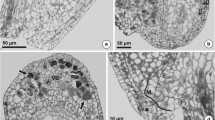Abstract
Apomixis represents an alteration of classical sexual plant reproduction to produce seeds with essentially clonal embryos, stimulating wide interest from biologists and plant breeders for its ability to fix heterosis. Eulaliopsis binata (Poaceae), is identified here as a new apomictic species. Embryological investigation indicates that the developmental pattern of embryo sac formation in E. binata represents gametophytic apospory, the embryo originating from an unreduced cell, without fertilization and the mode of endosperm development was autonomous. Sexual embryo sacs were found with a frequency of 1–4% depending on the biotype. The DNA content of nuclei (C-value) in mature seeds was screened by flow cytometry (FCSS) and demonstrated that the endosperm was derived autonomously without fertilization and the three biotypes of E. binata showed varying degrees of apomixis. The Wide-leaf type showed obligate apomixis whereas the Slender-leaf and the Red-haulm type displayed facultative apomixis. In addition, adventitious embryos were observed on the wall of ovary, integument and nucellus cells, indicating that E. binata produces embryos via a mixture of apospory and adventitious embryony.



Similar content being viewed by others
References
Asker SE, Jerling L (1992) Apomixis in plants. CRC, Boca Raton
Birchler J, Hart JR (1987) Interaction of endosperm size factors in maize. Genetics 117:309–317
Birchler JA (1993) Dosage analysis of maize endosperm of diplosporous apomictic Paspalum notatum. Sex Plant Reprod 11:331–335
Bicknell RA, Koltunow AM (2004) Understanding apomixis: recent advances and remaining conundrums. Plant Cell 16:228–246
Bradley JE, Carman JG, Jamison MS, Naumova TN (2007) Heterochronic features of the female germline among several sexual diploid Tripsacum L. (Andropogoneae, Poaceae). Sex Plant Reprod 20:9–17
Eckardt NA (2003) Patterns of gene expression in apomixis. Plant Cell 15:1499–1501
Grimanelli D, Hernandez M, Perotti E, Savidan Y(1997) Dosage effects in the endosperm of diplosporous apomictic Tripsacum. Sex Plant Reprod 10:279–282
Grimanelli D, Leblanc O, Perotti E, Grossniklaus U (2001) Developmental genetics of gametophytic apomixis. Trends Genet 17:597–604
Grossniklaus U, Spillane C, Page DR, Köhler C (2001) Genomic imprinting and seed development: endosperm formation with and without sex. Curr Opin Plant Biol 4:21–27
Hanna WW, Bashaw EC (1987) Apomixis: its identification and use in plant breeding. Crop Sci 27:1136–1139
Higashiyama T, Yabe S, Sasaki N, Nishimura Y, Miyagishima SY, Kuroiwa H, Kuroiwa T (2001) Pollen tube attraction by the synergid cell. Science 293:1441–1442
Higashiyama T (2002) The synergid cell: Attractor and acceptor of the pollen tube for double fertilization. J Plant Res 115:148–160
Kantama L, Lambert Y, Hu H, de Jong H, de Vries SC, Russinova E (2006) Use of the SSLP-based method for detection of rare apomictic events in a sexual AtSERK1 transgenic Arabidopsis population. Sex Plant Reprod 19:73–82
Koltunow AM (1993) Apomixis: embryo sacs and embryos formed without meiosis or fertilization on ovules. Plant Cell 5:1425–1437
Koltunow AM (2000) The genetic and molecular analysis of apomixis in the model plant Hieracium. Acta Biol Cracov Ser Bot 42:61–72
Koltunow AM, Grossniklaus U (2003) Apomixis: A developmental perspective. Annu Rev Plant Biol 54:547–574
Liu L (1988) Study on classification and evolution of Gramineae subfamily Panicoideae (in Chinese). Acta Phytotax Sin 26:11–28
Liu CH, Zhou ZX, Zhou Y, Yao JL (2006) RAPD analysis on genetic deversity of different populations in Eulaliopsis binata (in Chinese). Acta Bot Boreali Occidentalia Sin 26:915–920
Lord EM (2003) Adhesion and guidance in compatible pollination. J Exp Bot 54:47–54
Matzk F, Meister A, Schubert I (2000) An efficient screen for reproductive pathways using mature seeds of monocots and dicots. Plant J 21:97–108
Nogler GA (1984) Gametophytic apomixis. In: Johri BM (eds) Embryology of angiosperms. Springer, Berlin, pp 474–518
Noyes R (2006) Apomixis via recombination of genome regions for apomeiosis (diplospory) and parthenogenesis in Erigeron (daisy fleabane, Asteraceae). Sex Plant Reprod 19:7–18
Quarin CL (1999) Effect of pollen source and pollen ploidy on endosperm formation and seed set in pseudogamous apomictic Paspalum notatum. Sex Plant Reprod 11:331–335
Rojek J, Ruta E, Bohdanowicz J (2005) In vitro culture promotes partial autonomous endosperm development in unfertilized ovules of wild-type Arabidopsis thaliana var. Columbia. Sex Plant Reprod 18:29–36
Suen DF, Wu SS, Chang HC, Dhugga KS, Huang AH (2003) Cell wall reactive proteins in the coat and wall of maize pollen: potential role in pollen tube growth on the stigma and through the style. J Biol Chem 278:43672–43681
Tucker MR, Paech NA, Willemse MT, Koltunow AM (2003) Sexual and apomictic reproduction in Hieracium subgenus Pilosella are closely interrelated developmental pathways. Plant Cell 15:1524–1537
Wang et al. ZA, Li HP, Li SS (1992) Plant microtechnic. Sci Agric Press, Beijing
Yao JL, Yang PF, Hu CG, Zhang YD, Luo BS (2004a) Embryological evidence of apomixis in Eulaliopsis binata. Acta Bot Sin 46:86–92
Yao JL, Hong L, Zhang YD, Hu CG, Luo BS (2004b) Genetic diversity and classification of ecotypes of Eulaliopsis binata via morphological traits and AFLP markers (in Chinese). Sci Agric Sin 37:1699–1704
Zhang YD, Li HP, Yang XJ (1996) A preliminary study on apomixis in Eulaliopsis binata (in Chinese). J Huazhong Agric Univ 15:200–204
Zhou MT (1990) Study on water and soil conservation and cultivating technology of Eulaliopsis binata (in Chinese). WaterSoil Conserv China 9:35–37
Zhou Y, Yao JL, Kuang L, Liu CH (2005) Research advances about molecular mechanism of non-fertilization endosperm initiation (in Chinese). Acta Bot Boreali-Occidentalia Sin 25:2562–2568
Acknowledgments
We are grateful to Dr. Matthew Tucker for his advice and help in revising the manuscript. We are also grateful to Prof. Zhou Dao Xiu and Prof. Scott Russell for their help on this manuscript. This study was supported by the National Natural Science Foundation of China (30670127).
Author information
Authors and Affiliations
Corresponding author
Additional information
Communicated by Scott Russell.
Rights and permissions
About this article
Cite this article
Yao, JL., Zhou, Y. & Hu, CG. Apomixis in Eulaliopsis binata: characterization of reproductive mode and endosperm development. Sex Plant Reprod 20, 151–158 (2007). https://doi.org/10.1007/s00497-007-0051-y
Received:
Accepted:
Published:
Issue Date:
DOI: https://doi.org/10.1007/s00497-007-0051-y




